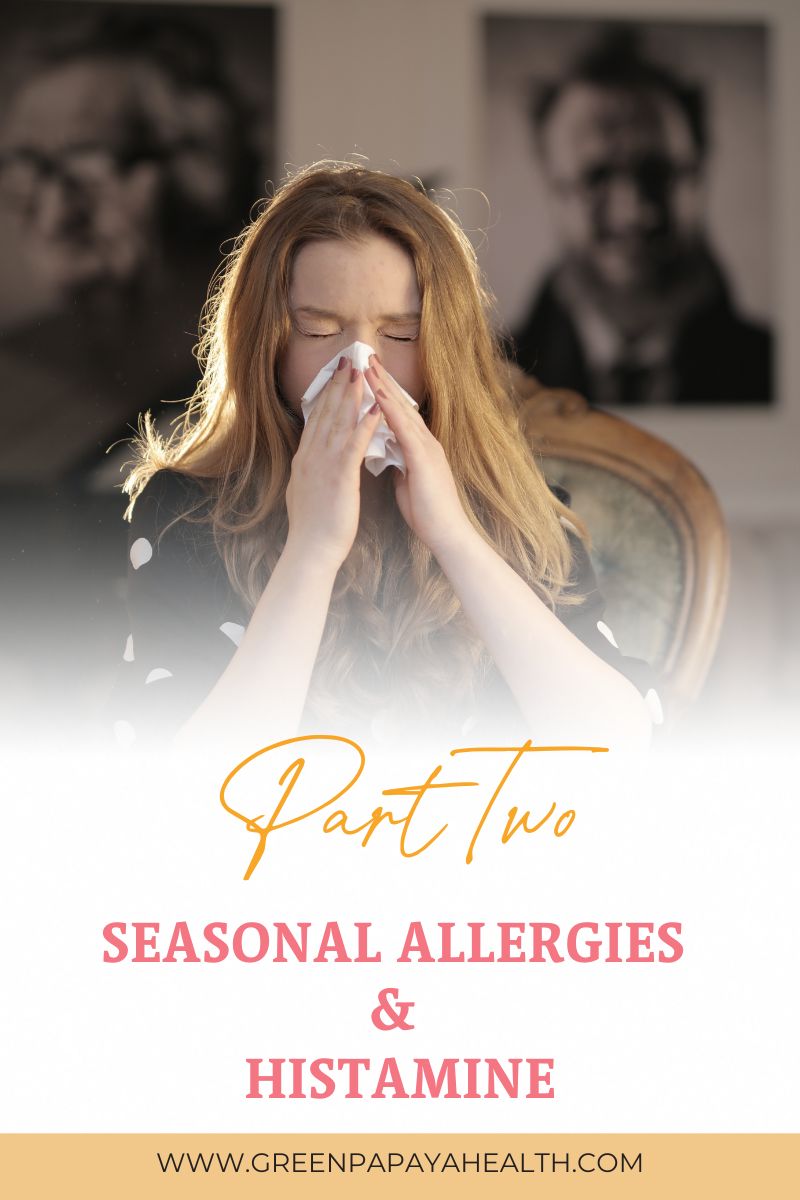Seasonal Allergies & Histamine Intolerance
Part Two in Our Seasonal Allergy Blog Series
In Part One of our Seasonal Allergy Blog Series, Dr. Fox and I talked about seasonal allergies and how mast cell activation syndrome (MCAS) is one potential root cause of allergy symptoms among those of us with complex chronic medical conditions. We discussed how mast cells release more than 200 chemicals when exposed to seasonal allergens and other foreign invaders, and how histamine is just one of the biochemical messengers that may be released in response.
In those with histamine intolerance, multiple chemical sensitivity (MCS), and overloaded immune systems (which is often the case in those of us with complex chronic illnesses), the mast cells may also activate when exposed to potentially harmful and harmless triggers. This is known as mast cell activation syndrome: a condition that occurs when the mast cells react inappropriately to normal stimuli. Triggers may include seasonal allergens, foods (including high-histamine foods), medications, scented products, sounds, chemicals, mold and mycotoxins, and just about anything else.
That being said, MCAS and histamine intolerance don’t always occur simultaneously. It’s very possible to have both MCAS and histamine intolerance, or just one or the other.
This post in our Seasonal Allergy Blog Series discusses histamine overload as a potential root cause of seasonal allergies.
What is histamine?
Let’s take a moment to define histamine, one of the chemical mediators released by our mast cells (allergy cells) when our bodies encounter foreign invaders (such as seasonal allergens, dust, and certain foods). This release of histamine and other chemicals is completely normal; it’s how the immune system protects us from allergens.
However, issues can arise when histamine builds up in our bodies to the point that it exceeds our histamine load (the amount of histamine we can safely handle). We may then develop histamine intolerance. This can happen when:
- Our bodies produce too much histamine.
- We eat a lot of high-histamine foods.
- We eat a lot of foods that trigger the release of histamine.
- Our bodies can’t break down histamine.
When we add MCAS into the mix, just about anything we encounter may trigger the release of histamine. But remember, not everyone with histamine intolerance has MCAS (and vice versa).
Histamine Intolerance as a Root Cause of Seasonal Allergies
When histamine builds up in your body and you’re unable to break it down, you may develop symptoms of histamine intolerance. An intolerance to histamine may cause you to experience some of the more common seasonal allergy symptoms (such as rhinitis, sneezing, runny nose, and congestion) as well as various gastrointestinal, nervous system, circulatory, and skin symptoms. You may experience these symptoms when exposed to seasonal triggers like pollen, mold, and grass — along with other triggers like certain medications, high-histamine foods, and beverages.
So, why can’t your body break down histamine like it’s supposed to? You could be deficient in two histamine-degrading enzymes: diamine oxidase (DAO) and histamine N-methyltransferase (HNMT). This could be due to inflammation in the gut, especially if you have food sensitivities, microbial overgrowth, an autoimmune condition such as Hashimoto’s disease, or another complex chronic illness. Certain medications (like NSAIDs) can also block the production of DAO.
How to Address Histamine Intolerance & Low DAO Levels
While adopting a low-histamine diet could help you to determine whether histamine intolerance may be contributing to your seasonal allergy symptoms (and make allergy season a bit more tolerable), it’s difficult to completely avoid high-histamine foods. Additionally, there are foods that trigger the release of histamine and other foods and medications that block DAO production. As such, many root-cause practitioners recommend a combined approach:
- Reducing foods and beverages high in histamine (e.g. fermented foods, fried fruit, vinegar, and leftovers).
- Reducing foods and beverages that trigger the release of histamine (e.g. alcohol, tomatoes, and certain nuts).
- Supplementing with DAO prior to eating and drinking (HistDAO™ from XYMOGEN is one option).
- Supplementing with DAO cofactors like copper, vitamin B6, and vitamin C.
- Reducing inflammation in the gut.
- Addressing MCAS, if necessary.
Of course, avoiding seasonal allergens can also help with managing histamine intolerance. When you head outdoors during allergy season, be sure to wear sunglasses and hats to protect your eyes, hair, and face from triggers — and keep your windows closed when pollen and mold levels are high. We also recommend purifying the air in your home (we love the AirDoctor), washing your bedding regularly, and keeping indoor humidity levels between 40 and 50 percent.
Stay tuned for the next few posts in our Seasonal Allergy Blog Series as we uncover other potential root causes of seasonal allergies!
Could histamine intolerance be a root cause of your seasonal allergies, skin complaints, and digestive distress? Functional medicine coaching can help! Book a call for Vital You or the Vital Basics Method™ and let’s get to the root cause of your chronic illness. Your body is made to heal!
References:
- Nathan, N. (2018). Toxic: Heal your body from mold toxicity, lyme disease, multiple chemical sensitivities, and chronic environmental illness (pp. 102-113). Victory Belt Publishing, Inc.
- https://www.ifis.org/blog/histamine-intolerances
- https://www.ncbi.nlm.nih.gov/pmc/articles/PMC7463562/
- https://acaai.org/allergies/allergic-conditions/seasonal-allergies/
- https://www.ncbi.nlm.nih.gov/pmc/articles/PMC8069563/
- https://www.ncbi.nlm.nih.gov/pmc/articles/PMC8308327/
- https://www.ncbi.nlm.nih.gov/pmc/articles/PMC6859183/







Pingback: Seasonal Allergies & Mold Toxicity - Vashti Kanahele